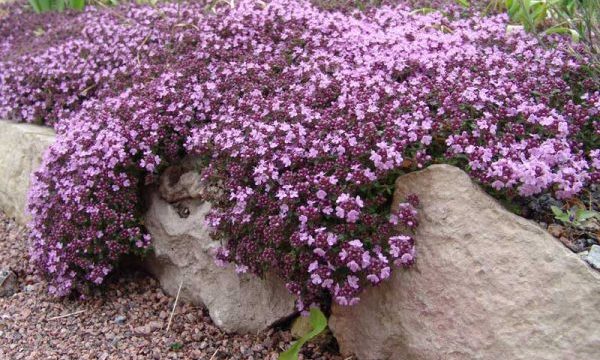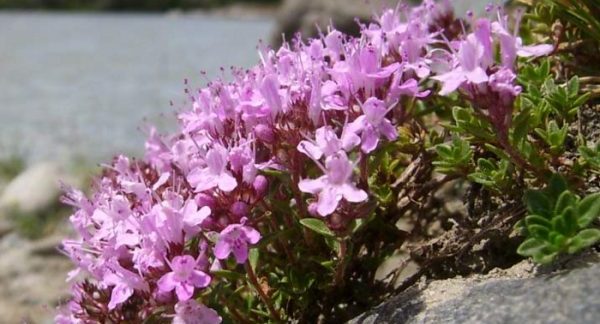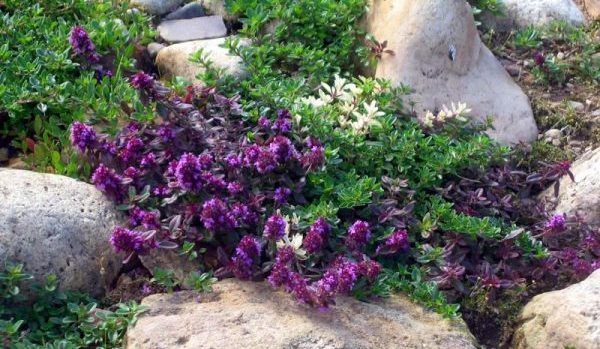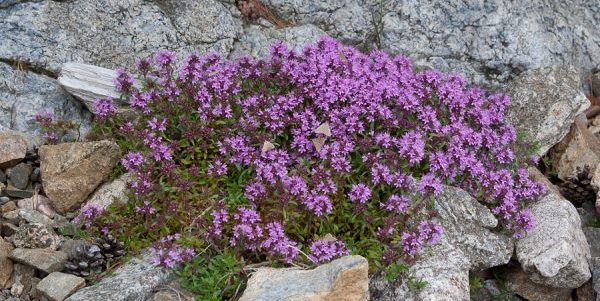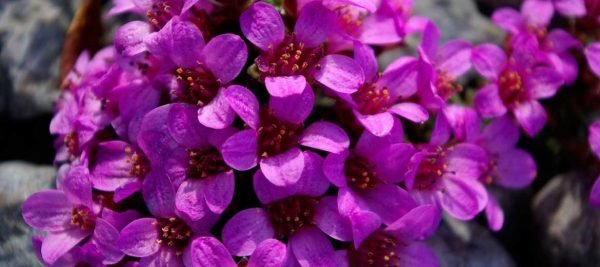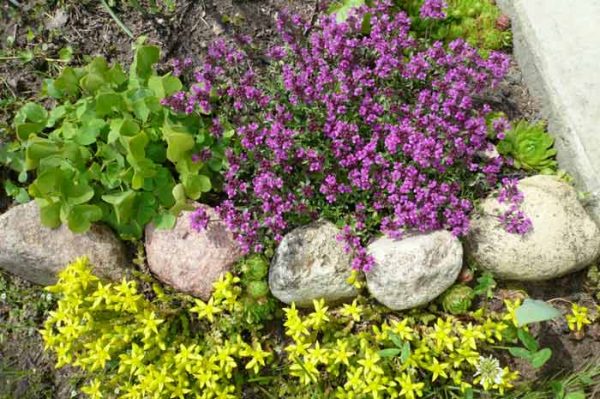How to grow and prepare creeping thyme
Content
Description of creeping thyme
The fragrant shrub creeping thyme is a perennial plant that creeps along the ground, forming a bright blooming carpet with a strong odor that differs in different varieties. Thin leafless stems of thyme quickly turn wood, they crawl along the ground, holding onto it with shallow roots, and from them grow up to 15 cm tender round twigs (or tetrahedral in some varieties) with small oval leaves, small flowers collected in a capitate inflorescence. Green leaves do not grow more than 1 cm long, they are usually oval, not pubescent, only at the base there can be white cilia along the edge. The flowers are small, two-lipped, the upper lip is flat, and the lower one is three-lobed. The color can be different: pink, lilac, bluish, violet, purple.
Thyme grows in the forest and forest-steppe zone of the European continent, spreads along the edges of forest edges, along rivers, on rocky slopes, even on rocks, loves sunny dry places. Thyme creeping, growing, densely covers the ground; during flowering, such thickets stand out beautifully among stones or other vegetation. There are many types and varieties of this plant, they differ in color of flowers and smell. The smell is often described as kerosene and lemon with different variations and shades.
Thyme blooms almost all summer, ripens in August. Each flower will give 4 slightly oblong, almost round nuts with a diameter of 0.5 mm. Bees are very fond of him, from pollen useful for them they create healing honey. The beauty of the flowering thyme, the original form of the overgrown plant attract landscape designers. It is often grown to decorate gardens, parks, courtyards, and must be planted when organizing a Mediterranean flower bed or alpine slides.
Creeping thyme is used by folk medicine to treat colds, bronchitis, pneumonia, asthma. It is recommended to use it for stomach diseases, spasms and bloating of the intestines, for neuralgia with chest pain, anemia, goiter, rheumatism. Tea with it soothes the nerves and saves from insomnia. All this is due to the beneficial substances that the herb contains. And it contains tannins, flavonoids, acids, bitterness and a truly healing essential oil, which contains the hydrocarbon cymene, terpenes, thymol, carvacrol. This composition explains the disinfecting, antibacterial, anti-inflammatory effect. The well-known expectorant "Pertussin" contains thyme extract.
Fresh and dried leaves are often used in cooking, especially when cooking meats and legumes. They are often used for home preservation, in pickles and marinades as a preservative, and not just a fragrant seasoning.
Video "All useful information about thyme"
Informational video about the beneficial properties of thyme.
Growing
Many people want to have such a wonderful plant in their summer cottage, so the cultivation of thyme is becoming very popular. It grows well on light sandy soils, so it is best to mix heavy soil with sand and compost (or peat) before sowing. The place must be sunny, without stagnant water and without drafts. Mindful of the decorativeness of flowering thyme, many plant it in flower beds or make a border out of it.
If the house has dried herb from the pharmacy, it makes sense to go through it, find the most withered flowers, shake the seeds out of them. Or you can just buy seeds. Fresh are the most germinating. They are so small that when grown from seed it makes sense to mix them with dry river sand before sowing for even distribution.
Sowing can be done in the spring, when the air temperature reaches + 20 degrees or before winter. You can sow seeds in August so that they have time to germinate before autumn, then cover them well for the winter. They do not need to be buried in the ground, you can just sow them in rows on damp ground, leaving 15 cm between them. You don't even need to cover them from above. After 10 - 18 days, shoots appear, they need to be thinned out, leaving 5 cm between the plants. In the first year, only tender green twigs will appear, in the second, flowers will appear, but the green mass has not yet grown so that it can be harvested.
If you press the vegetative shoots to the ground, sprinkle the branch itself, this will accelerate the growth of the bush, new roots and new branches will form. Cultivation of thyme, that is, caring for it, implies thorough weeding, rare watering and loosening of the earth. When the plants grow, their crown will close above the ground and there will be no room for weeds, and accordingly, there will be no need to weed.
After 5 years, the plants will begin to age, bald spots will appear in the solid carpet. This place can simply be covered with a small amount of fresh soil, and young shoots can be sent there. For the winter, plants need to be well covered with foliage or spruce branches. Although they live in the wild, in winter, especially if the snow blows off or after a thaw, they often freeze out. To prevent this from happening, young or adult plants must be covered before the onset of frost. If the bush has lost a lot of leaves, bare twigs need to be sprinkled with earth - they will form new roots, give young shoots.
Reproduction
Growing thyme from seeds is a surefire but long way. If you find an adult plant in nature or buy in a nursery, then you can bring it to the site, plant it in a permanent place, then dig in individual shoots so that new roots form, which means new shoots. You can divide the bush - just one small part, consisting of a pair of shoots and a root, is enough to settle creeping thyme in your country house.
Growing is possible through seedlings. To do this, it is enough to sow seeds in pots or boxes with damp soil, cover the sowing with glass. After the emergence of shoots, they are sprayed with water, kept on the window. When 2 true leaves appear, the plants are transplanted into separate cups. In April - May, when the temperature of the air and soil permits, the seedlings are planted in a permanent place.
Blank
From the beginning of flowering, the harvesting of raw materials is carried out. The flowering branches are carefully cut off - you cannot tear, because the roots in the sandy soil are not very deep and hold tight, if you pull, you can pull out the whole plant. If this happens, you need to return the plant to the ground as soon as possible, sprinkle the stem in several places with soil and water.
More than a third of the branches cannot be cut from one bush, the loss of more can weaken it so that growth slows down. The cut branches are dried by spreading out in a thin layer in a shaded place. At the same time, the temperature should not rise above + 35 degrees. Usually, only leaves and flowers are used for medicinal purposes - then the dried twigs are threshed.Cooking uses leaves, flowers, twigs, and crushes the dry material to form complex seasonings. Dry grass is stored in glass jars, tightly closed with lids, it retains its properties for 2 years.
Video "Recommendations for Gardeners"
Demonstration video with examples of the use of thyme and useful tips for gardeners.

